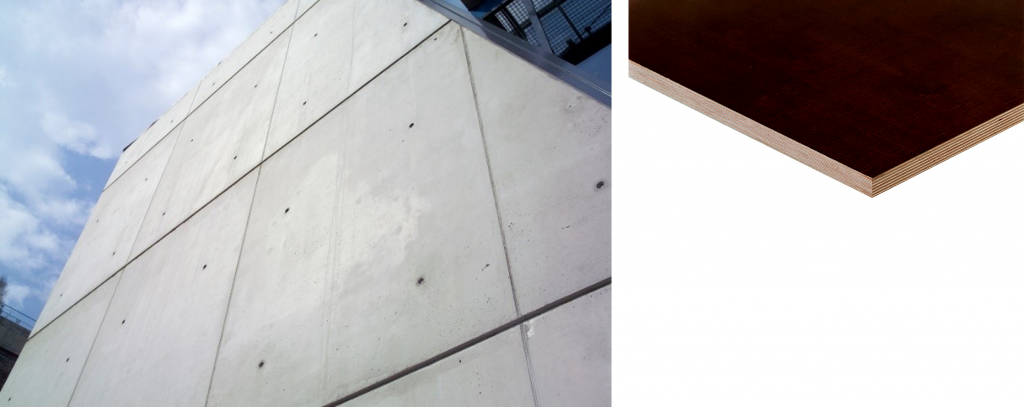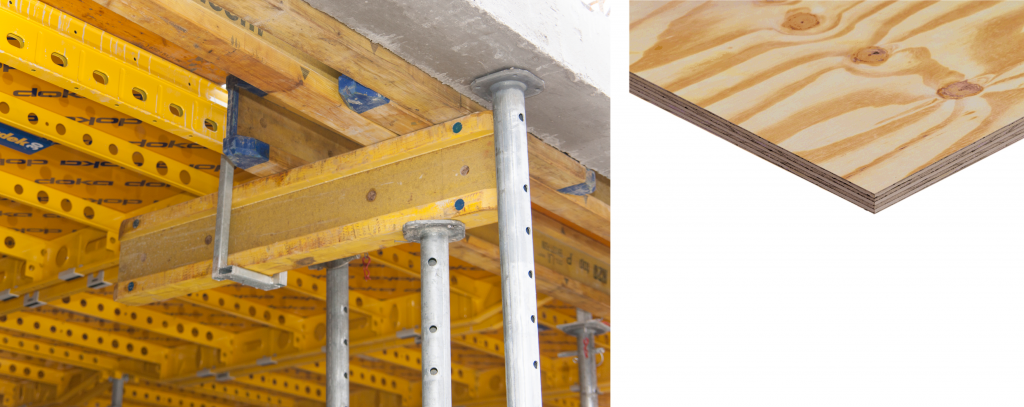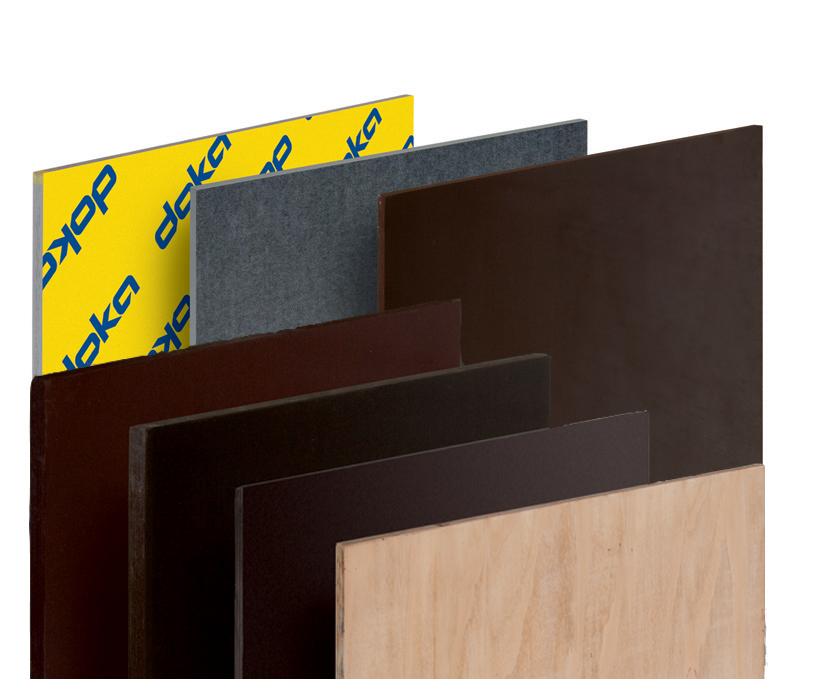Doka UK 5 September 2019.- The success of a project is often determined by the material you’ve chosen to work with. Plywood is one such example of an often over looked material which can have an important impact on the construction process and also the aesthetic design finish of any project as mentioned in our previous blog article ‘architectural concrete finishes with Doka’. There are ample examples to show that the quality and type of formwork sheets can impact profitability of any construction site. Crucial criteria in this respect are numbers of repeat uses the required concrete results and the acceptable amount of additional rework permitted. Therefore, it is important that the right plywood selection is made to achieve the chosen concrete results. For this reason, we discuss factors which are crucial in helping you to select the right plywood sheets for your project.
Selection process
Doka supports customers in the selection process of all formwork materials, which includes advice on the best plywood sheets for each unique project. If required we are able to supply a variety of plywood panel products which includes multi-ply formwork sheets – from birch for high reuse and high quality concrete finishes, to Medium Density Overlay (MDO) for typical formwork and shuttering site use and also natural plywood ideal for infill zones and non-critical areas. Usually pretreated with a release agent to facilitate stripping, Doka panels are available in many grades from products, for example with paper overlays such as MDO, which can add stability, resist abrasion, and provide a smoother and more durable forming surface if used correctly.
What factors should be taken into consideration before selecting your formwork sheets?
The key to selecting the right plywood is to do so based on your desired result, with the main focus being on function and strength in addition to appearance.Operating within the UK for over 20 years and globally for over 150 years, Doka have an understanding of what goes into the process of selecting the most suitable formwork sheets. Below we discuss five areas which should be considered before deciding upon the formwork sheets for your project.
1.- Field of use
Do you need the sheet for concrete formwork, for infill areas or for construction site setup? These factors will all play a part in the selection process of your plywood sheets.
If a fair-faced concrete finish is required, the right formwork sheets are required to achieve premium concrete surfaces. Dokaplex, Xface and DokaPly birch formwork sheets are ideal for fair-faced forming. For infill zones, when using framed formwork systems, DokaPly natural is a good choice.


2. Type of application:
Each formwork sheet has its own characteristics and reveals its benefits through the right application – this can depend on whether you use it for walls or slabs.
Doka offers a variety of formwork sheets which are used in conjunction with numerous Doka formwork systems. Take Doka’s high-grade plywood sheet Xlife for instance. The Xlife sheet is a high-grade plastic/wood composite sheet with hard-wearing plastic coating for a significantly longer lifespan and uniform concrete faces over a long time of service.
Another example is the Dokaplex formwork sheet which is a high-grade birchwood-veneer plywood sheet with film coating on both sides, for horizontal and vertical formwork applications.
3. Number of uses:
Do you have requirements on how often you want to use the formwork sheet or on the result of the concrete surface?
You must decide on how many pours that you would like from each plywood sheet. The question of how many pours are achievable with a single piece depends not only on the product itself, but also its careand maintenance. Doka recommend to store the panels on level ground, raised on smooth wooden battles well clear of mud or standing water and away from any risk of contact with vehicles or machinery when not in use. If stored for a lengthy period outdoors, it is also recommended to remove the original strapping and packaging whilst storing under an appropriate waterproof tarpaulin or shelter to ensure that air flows freely to avoid moisture build-up and condensation.
Cleaning is also vital to extend the life of the plywood for as long as possible. It is important to ensure faces are cleaned and re-oiled immediately after they are struck as otherwise they are likely to be damaged when removing fully cured concrete from the surface. The used surface should be stored away from the sun, to reduce the risk of rapid moisture loss from the face veneer.
The number of cycles possible and frequency of use depends on many factors acting on the formwork sheet. Careful site handling and cleaning of the formwork plywoods between castings prolongs the service life of the panels, and gives better results to the surface quality of the concrete.
Many factors can affect the number of pours anticipated from concrete-forming plywood. Some of these include the following:
- Desired finish on the concrete
- Durability of the panel’s surface, including overlays
- Types of concrete formulation
- Which release agents are used
The most critical factor is the handling and care of the panels as mentioned previously. With reasonable maintenance, up to 30 pours can be expected from DokaPly birch, while MDO panels can withstand up to 15 reuses and the Xlife sheet up to 150 reuses.
4. Format & type:
We would also recommend that you fill in criteria that your plywood sheet should fulfill. This could include the following:
- Sheet thickness
- Sheet type (three-ply or plywood sheet)
- The format
5. Quality
You must decide on what you would like the result of the concrete surface to look like. In addition to the plywood itself, it is important to remember that other factors such as the type and amount of release agent used on the sheets can alter the final finish of the concrete itself and needs to be tested or controlled when installing on a fair faced concrete requirement. Another factor we have previously discussed is the management of the concrete maturity and the correct selection of concrete on fair faced concrete finishes by using a system such as Concremote. By managing the maturity of the concrete and striking the formwork at the right time a more consistent colour finish can be achieved on the structures.
In order to produce a fair-faced concrete finish, remember to keep the following in mind:
- Protect the formwork sheeting from moisture absorption and drying out
- Do not expose the panels to direct sunlight
- The formwork is best stored upright (in shade during summer months), 2 panels with sheeting face to face
- If panels are stored flat there is a possibility of the stacking rails marking the sheeting face
- Understand the concrete maturity measurements using Concremote from Doka to strike the formwork at the right time
Doka supply FSC®certified plywood
There is a growing demand for more sustainable and responsible products to be used covering all areas of construction. Therefore, we have ensured that our core Dokaply Birch, MDO and Natural products are FSC® certified and that Doka in the UK hold FSC® Chain of Custody Certification for the storage and handling of approved products in all of our three operating locations. This certification means that the wood materials come from sustainably managed forests. Using FSC® plywood means you are protecting the environment against deforestation and illegal harvesting.
For more information on our plywood range, visit our website or contact us directly on 01622 749050.







